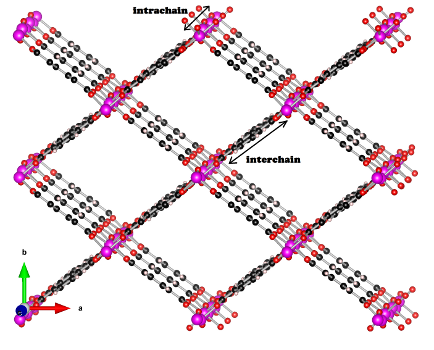Magnetism in 1 or 3 dimensions: Magnetic MOFs
Magnetism in 1 or 3 dimensions: Magnetic MOFs
Promotor(en): V. Van Speybroeck, D.E.P. Vanpoucke /15_NANO17 / Nanoporous materialsMetal-organic frameworks (MOFs) are nanoporous materials consisting of metal clusters linked through organic molecules. The variability of these building blocks provides great opportunities for focussed design, demanding detailed insights in the role they play in the MOFs’ overall properties.
From the fundamental point of view, MOFs show many interesting properties. Certain MOFs exhibit specific magnetic and multiferroic properties. Other porous MOFs show, under external stimuli (temperature, pressure or gas sorption), reversible flexible behaviour, called breathing leading to large variations of the pore size while maintaining the topology of the MOF. The MIL-53(Al) MOF, with Al-OH centres, is a well-known breathing MOF under ambient conditions. The structurally very similar MIL-47(V) MOF, with V=O centres, shows no breathing behaviour under ambient conditions. In addition also a MIL-53 MOF with V has been observed where the V atoms are assumed to be trivalent, in contrast to being tetravalent in the MIL-47 MOF. The presence of one or two unpaired electrons on the V atoms gives access to an abundance of possible magnetic configurations.

Many transition metals and their oxides are known for their (complex) magnetic behaviour. This is also true for transition metals in MOFs: the MIL-47(V) and MOF-74(Fe) are known to show magnetic transitions due to temperature or the introduction of guest molecules. Other MOFs show 1D magnetic behaviour. This makes a detailed knowledge of the ground state magnetic configuration and stability of great interest.
In this topic, the ground state magnetic configuration for MIL-53/47 like MOFs with different metal oxide clusters will be investigated. Inter-and intrachain interaction strengths will be derived and correlated with the metal used. Also the influence of the magnetic order on the flexibility of the MOFs will be a point of interest. “Can MOFs be used as magnetic sensors?” is one of the questions that will be answered in this topic.
Interested students will be trained in the use of the required quantum mechanical codes and tools necessary for this topic.
- Study programmeMaster of Science in Engineering Physics [EMPHYS], Master of Science in Physics and Astronomy [CMFYST]ClustersFor Engineering Physics students, this thesis is closely related to the cluster(s) Modelling, Fundamentals, Nano, Materials

